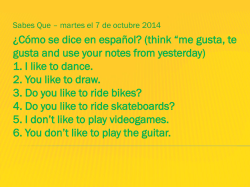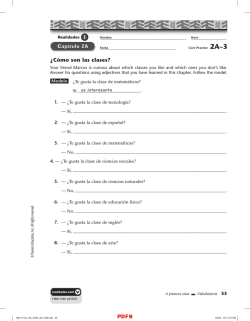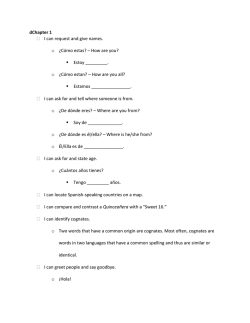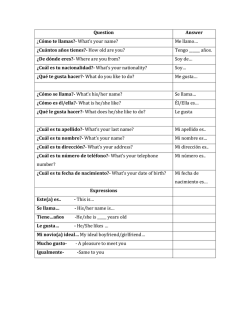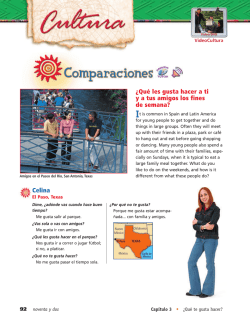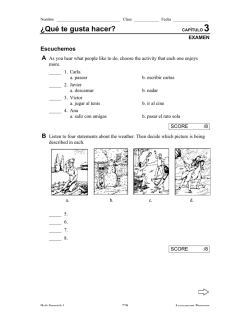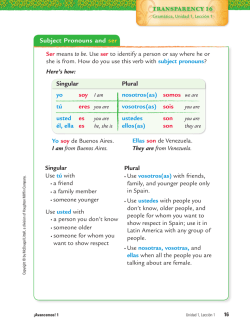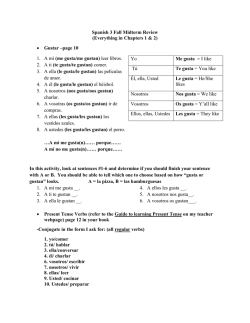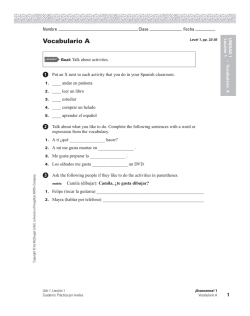
SALUDOS GREETINGS PROFESIONES PROFESSIONS ¿Cómo
Español 1 -- 7mo grado
Profe Mejía
Guia de la Unidad 1, etapa 1
¡Bienvenido a Miami!
SALUDOS
GREETINGS
PROFESIONES
PROFESSIONS
¿Cómo está usted?
How are you? (formal)
el (la) doctor(a)
doctor
¿Cómo estás?
How are you? (familiar)
el (la) estudiante
student
¿Qué tal?
How is it going?
el (la) maestro(a)
teacher
¿Qué pasa?
What’s up
el (la) policía
police officer
¿Qué más?
What’s up
LUGARES
Hola
Hi
la comunidad
community
Estoy...
I am
el vecindario/el barrio
neighborhood
(No muy) Bien, ¿y
tú/usted?
Regular/más o menos
(Not very) Well, and you
(familiar/formal)?
so-so
el mundo
world
el país
country
Terrible
awful, terrible
chévere
Fine/very well
Gracias
Thank you
OTRAS FRASES /
PREGUNTAS
¿De dónde + ser...?
OTHER PHRASES/
QUESTIONS
Where is...from?
De nada
You're welcome
ser de...
to be from...
el apartamento
apartment
la casa
house
PEOPLE
PLACES
LA GENTE/ LAS
PERSONAS
el (la) amigo(a)
friend
bienvenido(a)
welcome
la chica
girl
el concurso
contest
el chico
boy
el lugar
place
la familia
family
mucho(os/a/as)
much, many
el hombre
man
no
not
la muchacha
girl
o
or
el muchacho
boy
pero
but
la mujer
woman
también
also
el señor
Mr.
y
and
el joven
Young man
la señora
Mrs.
la señorita
Miss/young girl
ACTIVIDADES
ACTIVITIES
bailar
to dance
cantar
to sing
comer
to eat
correr
to run
escribir
to write
leer
to read
nadar
to swim
patinar
to skate
trabajar
to work
Palabras nuevas
New words
Grammar Summary -- Unidad 1 -- Etapa 1
Familiar and Formal Greetings
There are different ways to say "how are you?" in Spanish:
is a "familiar" greeting, used with friends, family members, or someone younger
than you (and your pets!). It uses the "tú" form of the verb estar. "Tú" is the
familiar or informal way to say "you."
is a formal greeting, used with a person you don't know, someone older than you, or
someone for whom you want to show respect. It uses the "usted" form of the verb
estar. "Usted" is the formal way to say "you."
INTRODUCTIONS
When you want to introduce somebody, you need to use either the formal or familiar forms,
depending on who you are talking to…
Use the formal “le presento a” …. If you also would use a formal greeting
Example: Sr. Estrada, le presento a mi amigo Raúl.
Use the familiar (or informal) introduction “ te presento a”… if you are talking to someone
that you would greet in a familiar way, as above.
Example: Hola Marta (a friend), te presento al Sr. Estrada.
Practice it:
Hola Profe Mejia, _____ presento a Lucy, una nueva estudiante.
SUBJECT PRONOUNS & VERB SER
To discuss people in Spanish, you will often use "Subject Pronouns," which are words like "I, you, he, she."
To describe a person or explain who they are, use the verb ser. This verb is what is called an "irregular verb,"
because it does not follow the pattern of conjugation used for regular verbs.
S --- SER
T -- Time
O -- Occupation/origin
P -- Personality/profession
En Español
En Ingles
T -O -P -I -C --
VERB SER –
Example using the verb
Plural
Singular
Pronombres:
or
NOTE:
If you were to say that someone is a neighbor, you would say: Él es un vecino ("un/una"
means "a" or "an"). But if you were to say that someone is a policeman, you would say: Él es
policía. (The word "un/una" does not appear before a profession)
The VERB VIVIR
To live in – vivir en- to say where you live, such a building, apartment, a city, a house, etc. Use the
conjugate verb + the preposition “en”.
Pronombre
Yo
Tu
Él/ Ella
Usted
Nosotros
Vosotros
Ellos/ellas
Ustedes
Vivir- conjugate
Write an example
Expressing likes & dislikes, using IOP + gustar + Infinitive
You already learned how to use gustar to say I like, you like and he/she likes to do something. Now
you can talk about what other people like to do using the
indirect object pronoun (IOP) + GUSTA + infinitive verb
If person
is:
USE this
IOP
Me
Te
Le
Add GUSTA +
another verb
Gusta + verb
Gusta + verb
Nos
Os
Les
Example
(using bailar)
me gusta bailar
te gusta bailar
le gusta bailar
nos gusta bailar
os gusta bailar
les gusta bailar
I like to …
You like to (fam.) …
He, she, it, You (formal)
like(s) to…
We like to…
You (fam.pl.) like to…
They, you (pl) like to…
Indirect object pronouns are used to indicate "to whom" or "for whom" an action is
performed. Remember that with gustar the action or thing you like is the subject of the
sentence and controls how the verb is conjugated. So the sentence me gusta bailar
translates literally as "to dance is pleasing to me.")
When you want to emphasize or identify the person that you are speaking about, use:
A + name/noun/pronoun in front of the pattern in the table above:
A + person +IO pronoun + GUSTA + Infinitive
I like =
A mi me gusta bailar
You (fam.) like =
A ti te gusta bailar
He, she, it, You (formal) like(s) =
A él/ella/usted le gusta bailar
We like =
A nosotros(as) nos gusta bailar
You (fam.pl.) like =
A vosotros(as) os gusta bailar
They,you (pl) like =
A ellos(as)/ustedes les gusta bailar
Write a couple of examples below:
1. ___________________________________________________
2. ___________________________________________________
© Copyright 2026
